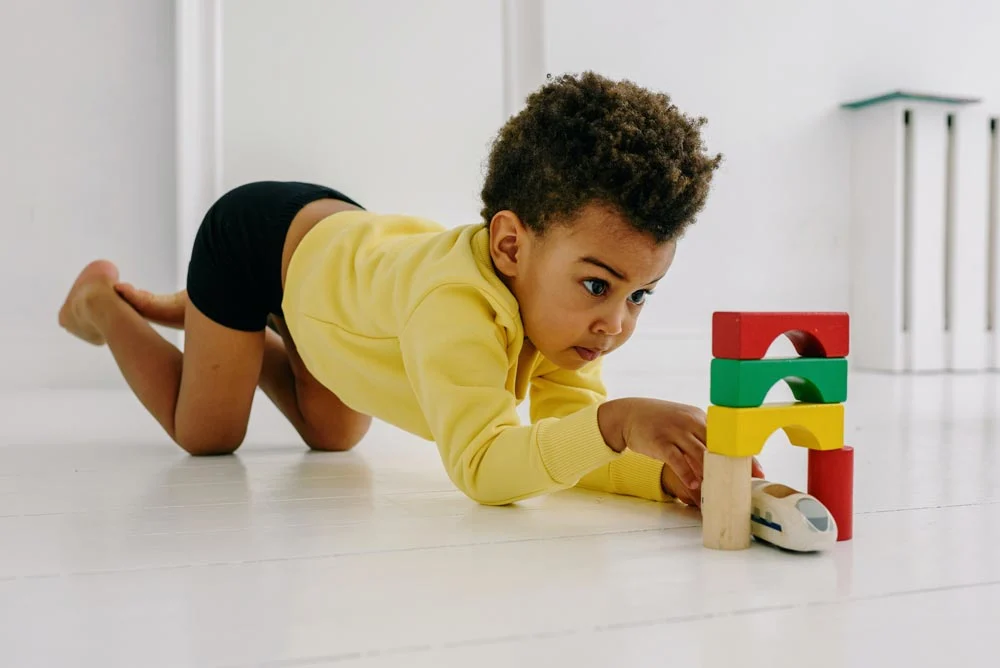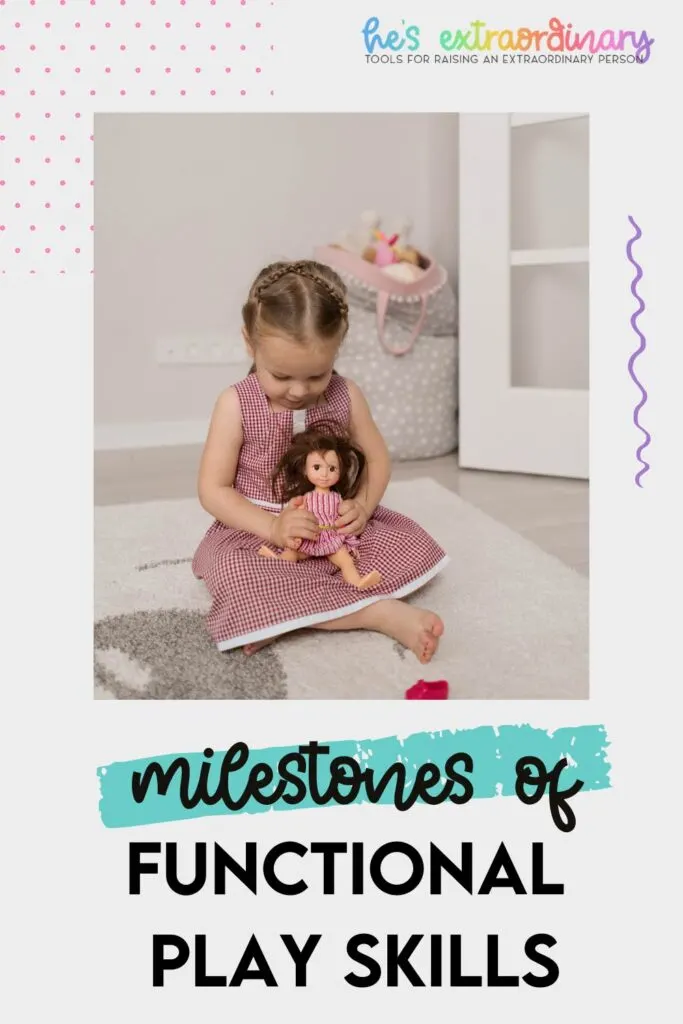What’s inside this article: Developmental milestones associated with functional play skills, additional play behaviors, and tips for helping children with autism develop functional play skills, which are a crucial part of childhood development.
Disclaimer: This post contains affiliate links.

When you’re a child, playing is your work.
Playing should be fun and functional because during childhood most learning is done through play-based activities. Functional means the play serves a purpose.
There are actually different categories of play and children’s play skills should progress through a set of milestones for each category.
This post isn’t going to include the age when each milestone should be met. Age milestones are based on typically developing children and often don’t accurately represent childhood development.
The age is not important, nor is how fast it takes your child to progress. What’s important is that your child is moving forward and will eventually get there.
It doesn’t matter how slow a child learns as long as we encourage them not to stop
A halt in play skills development can affect development in other domains- especially social-emotional learning and life skills.
Take a few minutes to read through the lists and ask yourself: are your child’s functional play skills progressing? Plus, how can you help if they aren’t meeting the milestones of play?
This post is part of a 7 part series on techniques for improving communication skills. Each part of the series contains this table of contents so you can easily navigate to the other parts of the series.
Although this post is about functional play skills, it is included in the communication series because teaching language and communication through play is the most effective way to learn new skills, and is the basis of most early learning in childhood development.
Table of Contents
- Learning to Listen & Oral Language Comprehension
- Developing Oral Language Expression
- Developing Social Language and Conversation Skills
- Milestones of Play & Targeting Skills Through Play
- Augmentative and Alternative Communication Tools
- Childhood Development: Language and Communication Milestones
- The Functions of Echolalia
Play Level Progression
The progression of functional play skills is broken down into five categories:
Read through the expected progression of skills and consider if your child currently engages in that type of play. You should answer yes, no, or sometimes.
Evaluating your child’s play skills will help you meet them at their current level of ability and encourage the development of more advanced skills.
Be aware that their ability level may vary greatly from one category to another. Also, they may have moved past an early method of play and onto a more progressed skill within a category, so if they no longer do some of the earlier skills, that is to be expected.
1. Sensory Exploration
Uses senses to explore objects:
This is the first form of play you’ll see, typically starting in infancy.
Your child may put objects in their mouth, sniff objects, or visually inspect an object.
At this beginning stage, your child may also do different actions with all objects and toys they hold, such as banging, shaking, or spinning.
Repetitive sensory exploration:
Your child engages in a single form of sensory play repetitively for extended periods of time. Some kids will engage in this type of play so much so that they do not play any other way.
Object exploration:
Some children explore objects by looking for differences in shape, color, texture, etc.
During this stage, your child may pull, turn, poke, and tear objects. Your child will use one object or toy at a time but change objects often.
2. Early Relational Play
Cause-and-effect play
At this stage, your child is beginning to combine objects in a container, push on buttons, turn handles, opening and shutting things, etc.
Your child may throw a toy in play (not to get rid of it). They may be able to put some objects together and enjoy toys such as shape sorters and busy boards.
During this stage of functional play skill development, your child is using play to understand cause-and-effect and better understand the world around them.
Relational Play
Your child is starting to use toys in a more functional way.
They now engage in activities such as pushing a toy car, blowing into a noisemaker, placing a ring on a ring stacker, etc.
Basically, they’re using a toy in the way it’s expected to be used.
3. Symbolic or Pretend Play
Early pretend play – directed toward self:
This is the very first stage of pretend play.
Your child will begin pretending by doing familiar actions towards themselves. They may pretend to sleep, comb their hair, talk on the phone, etc.
They may use realistic toys or objects and make sounds. For example, pretending to talk on a toy phone, pretending to put on makeup with a plastic lipstick, etc.
They may say “Moo” while playing with a toy cow or pretend to eat toy food and make chomping noises.
Early pretend play – directed toward others
Your child is starting to pretend toward other people, too. At this stage, they may pretend to feed you, a sibling, or even a toy doll.
Feeding and grooming are usually the first pretend-play activities to emerge.
Linking pretend actions
Your child now performs the same pretend-play actions on multiple play partners – for example, they pretend to feed themselves, feed their mom, feed their dad, feed their doll, drink from several cups, etc.
Your child is moving on from using realistic toy objects in play to using substitute objects.
For example, pretending a block is a cookie. Where before they would only pretend a toy cookie was a cookie.
The substitute objects often look similar to the real object (same shape, color, etc).
Your child may now pretend to pour and drink juice at this stage, or pretend their toy stove is hot.
Symbolic sounds and gestures
Your child is now using sound effects in their play. They may use a different voice now for their doll or say “choo-choo” as they drive their toy train.
Linking symbolic actions
Pretend play starts becoming more complex now as your child starts linking together a variety of play actions.
For example, they may feed their doll, then put them to sleep. Or, pretend to put gas in their car before driving their car.
Doll as an active agent
Before now, your child was using their dolls (or toys) passively in play – doing pretend actions to them. Now the doll becomes an active agent. Your child may make the toy or doll walk, hold a spoon and eat, kick a ball, etc.
Advanced substitute object use
Next, your child starts using substitute objects for a missing toy during pretend play.
They may use items as pretend food or pretend to wash a car without any cloth or water.
Unlike before, the substitute objects may not look anything like the real object.
Telling stories with toys
This is the last developmental stage of pretend/symbolic play. Your child can now act out a complex story using their toys.
For example, they may pretend to drive a car, crash the car, fix the car, all as part of a single play sequence. Or they may give their doll a bottle, burp the doll, change the doll’s diaper and put it to bed.
4. Sociodramatic Play
This is the most complex level of functional play. When your child’s play skills reach this level they will begin assigning multiple roles to themselves and other play partners such as siblings.
This stage starts with familiar play themes and progresses to fantasy characters and stories they create.
They may use props, substitute objects, and toys, or may simply play using language and gestures alone.
This type of play is very elaborate and often very difficult for children with autism. They may never reach this level.
5. Games With Rules
Simple games
Learning games occur along with object play. Your child learns to take turns and follow directions of simple games.
This includes games such as a tag, or freeze dance, hide-and-go-seek, etc.
Manipulative games
Your child can play simple games which have a few rules or steps and also a manipulative component. “Don’t Break the Ice” is a great example of a beginner manipulative game.
Another popular example is the classic game Operation.
Board Games
Your child is developing problem-solving skills and is able to follow rules.
They are moving on to board games that require some skill and have more complex rules. Connect 4 is an excellent beginner game that encourages problem-solving and strategic thinking.
Organized sports and playground games
Your child can play gross motor games, even if they are only at a beginner’s level. These are games such as baseball, or soccer and include anything from an organized game to a few kids throwing or kicking the ball on the playground.
As your child progresses toward this level of play you can facilitate by teaching games in steps and offering assistance.
Additional Play Behaviors
As your child’s functional play skills develop, also assess their progress with these additional play behaviors:
- Stereotyped Play: Do they have advanced play skills, but only play with one toy, or complete the same sequence of play actions with every toy they encounter?
- Duration of Play: Does your child have a difficult time staying with one toy for a period of time and move very quickly between available toys?
- Facilitated Play: Look at the highest level of play skills your child has achieved in each category above. Are they able to engage in this form of play spontaneously, or do they need your help?
Helping Your Child Develop Functional Play Skills
So what can you do, if your child’s play skills seem to have halted in a certain category, are progressing slowly, or if their play is stereotyped, needs to be facilitated, etc.?
You can actually teach play skills, and more complex levels of play can be learned. Encouraging the development of your child’s play skills can be beneficial for your child in all areas of development.
So, where can you begin?
Modeling Play Skills
You can teach play skills to your child by modeling that type of play yourself. Take a look at the list of milestones and the highest level of play your child has achieved in each category.
From there – you should model play skills that are one level higher than your child’s current skill level. These are the skills you answered “no” or “sometimes” since they are just emerging skills.
Sitting and playing with your child is one of the absolute best ways for your child to learn.
You should continue to model the functional play skills you want to develop until your child has mastered that skill. Additionally, include the other already developed skills as you play, so they can be maintained.
For board games and other games with rules – consider some of the beginner games mentioned above.
As you move on to teaching your child organized sports or playground games think about all the skills involved in playing that game.
For example – to play baseball you must be able to throw the ball, catch the ball, hit the ball with the bat, and run the bases. Start teaching one step of playing the game at a time. You can also develop task strips to help teach your child the sequences involved in playing the game.
Additional Play Skills
If you want to increase the duration your child plays with a single toy keep all toys away and only introduce a single toy at a time.
Slowly increase the amount of time required to play with a single toy before introducing another toy to your child.
If your child only engages in facilitated play and needs help make sure you work on spontaneous play and initiation before moving on to a higher level of prompted play.
Use positive reinforcement while encouraging your child to initiate play independently.
If your child’s play is stereotypical and they complete the same sequence with a toy every single time, model different ways of playing with that toy.
Start by modifying your child’s play sequence only very slightly and progressively increase the different ways to play with a single toy.
Children with autism are often very rigid and it can be overwhelming if you push too hard for them to play differently.
Do not move on to model a more complex play level until your child is playing with toys in a variety of ways.
The information in this post was obtained from “Classroom Pivotal Response Teaching for Children With Autism” by Aubyn C, Stahmer, Jessica Suhrheinrich, Sarah Reed, Laura Schreibman, and Cynthia Bolduc.
This book presents a research-supported behavioral intervention for children with autism that teachers can easily integrate into their existing classroom curriculum. You can purchase the book on Amazon.


